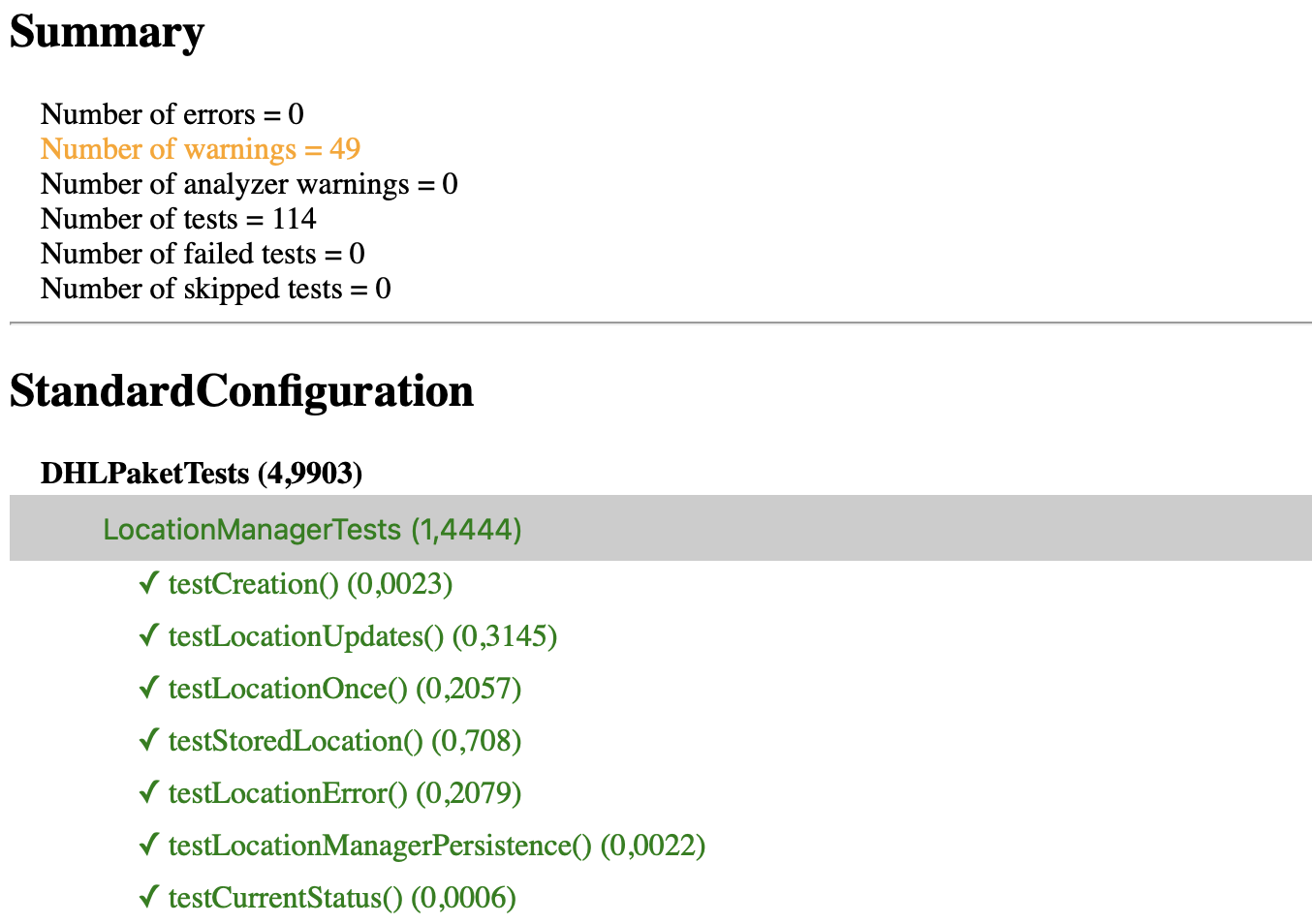Parse the binary xcresult bundle from Xcode builds and testruns
Interpret binary .xcresult files and print summary in different formats:
- txt
- colored command line output
- xml
- html
In case of 'xml' JUnit format for test results and generic format (Sonarqube) for coverage data is used.
You can also specify the name of the project root. Paths and urls are then relative to the specified directory. (used for urls in xml output)
This tool can read test result data and code coverage data from an .xcarchive using the developer tools included in Xcode 11. Namely here: xcresulttool and xccov to get json data from .xcresult bundles.
Parsing the JSON is done using the great XCResultKit package.
Unfortunately converting to the coverage xml format suited for e.g. sonarqube is a tedious task. It requires us to invoke the xccov binary for each single file in the project.
First we get a list of source files with coverage data from the archive, using xccov --file-list and then we need to invoke xccov for each single file. That takes a considerable amount of time. So at least we can spread it over different threads, so that it executes in parallel and is overall faster.
Until now we used xccov-to-sonarqube-generic.sh which does the same job, just in a shell script. It has the same problem and since it can not spawn it to different threads, it takes about 5x the time.
- Download
xcresultparser.zipbinary from the latest release - Copy
xcresultparserto your desktop - Open a Terminal window and run this command to give the app permission to execute:
chmod +x ~/Desktop/xcresultparser
IMPORTANT NOTE: This binary is not notarized/certified by Apple yet. So you must go to SystemSettings:Security and explicitely allow the app to execute, after the first attempt to launch it in the terminal, in case you want to take the risk. I will try to notarize it asap and get rid of this 'Important note'.
Or build the tool yourself:
- Clone the repository / Download the source code
- Run
swift build -c releaseto buildxcresultparserexecutable - Run
open .build/releaseto open directory containing the executable file in Finder - Drag
xcresultparserexecutable from the Finder window to your desktop
Assuming that the xcresultparser app is on your desktop…
Open a Terminal window and run this command:
cp ~/Desktop/xcresultparser /usr/local/bin/
Verify xcresultparser is in your search path by running this in Terminal:
xcresultparser
You should see the tool respond like this:
Error: Missing expected argument '<xcresult-file>'
OVERVIEW: Interpret binary .xcresult files and print summary in different formats: txt, xml, html or colored cli output.
USAGE: xcresultparser [--output-format <output-format>] [--project-root <project-root>] [--coverage ...] [--version ...] [--quiet ...] <xcresult-file>
ARGUMENTS:
<xcresult-file> The path to the .xcresult file.
OPTIONS:
-o, --output-format <output-format>
The output format. It can be either 'txt', 'cli', 'html' or 'xml'. In case of 'xml' JUnit format for test results and generic format (Sonarqube) for coverage data
is used.
-p, --project-root <project-root>
The name of the project root. If present paths and urls are relative to the specified directory.
-c, --coverage Whether to print coverage data.
-q, --quiet Quiet. Don't print status output.
-h, --help Show help information.
Now that a copy of xcresultparser is in your search path, delete it from your desktop.
You're ready to go! 🎉
The tool doesn't create any file. It justs outputs its results to standard out. It is up to you to write the output to a file, using redirection.
For example, if you want to write the text output into a file named output.txt on your desktop:
./xcresultparser -o txt test.xcresult > ~/Desktop/output.txt
However, if all you need is to output the contents of the xcresult bundle to the terminal:
./xcresultparser -o cli test.xcresult
Print the test results in color to the command line:
./xcresultparser -o cli test.xcresult
Create a single html file with test data
./xcresultparser -o html test.xcresult > testResult.html
Create an xml file in JUnit format:
./xcresultparser -o xml test.xcresult > junit.xml
Create an xml file in generic code coverage xml format:
./xcresultparser -c -o xml test.xcresult > sonar.xml

